| Abbey Church of Sainte-Foy | |
|---|---|
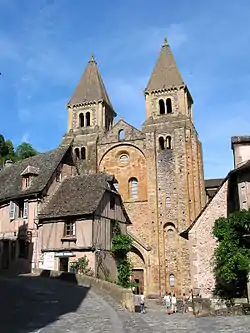 | |
| General information | |
| Location | Conques, France |
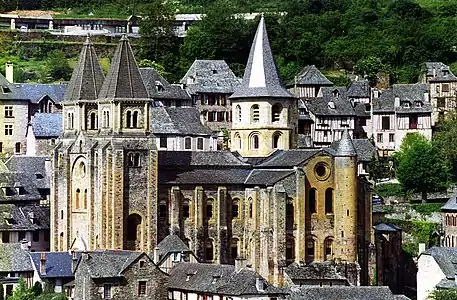
.jpg.webp)
The Abbey Church of Sainte-Foy in Conques, France, was a popular stop for pilgrims traveling the Way of St. James to Santiago de Compostela, in what is now Spain. The main draw for medieval pilgrims at Conques were the remains of Sainte-Foy, a young woman martyred during the fourth century. The relics of Sainte-Foy arrived in Conques through theft in 866. After unsuccessful attempts to acquire the relics of Saint Vincent of Saragossa and then the relics of St. Vincent Pompejac in Agen, the abbey authorities set their sights on the relics of Sainte-Foy at the ancient St. Faith's Church, Sélestat.[1] The Conques abbey opened a priory next to the shrine in Sélestat. A monk from Conques posed as a loyal monk in Agen for nearly a decade in order to get close enough to the relics to steal them.[2] The abbey church is a listed monument since 1840.[3]
Architecture
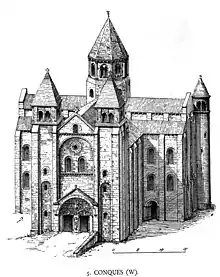
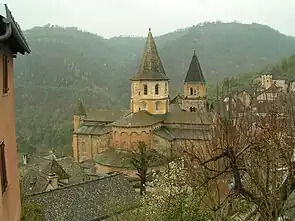
The original monastery building at Conques was an eighth-century oratory built by monks fleeing the Saracens in Spain.[2] The original chapel was destroyed in the eleventh century in order to facilitate the creation of a much larger church[4] as the arrival of the relics of Sainte-Foy caused the pilgrimage route to shift from Agen to Conques.[2] The second phase of construction, which was completed by the end of the 11th century, included the building of the five radiating chapels, the ambulatory with a lower roof, the choir without the gallery and the nave without the galleries.[4] The third phase of construction, which was completed early in the twelfth-century, was inspired by the churches of Toulouse and Santiago de Compostela. Like most pilgrimage churches Conques is a basilica plan that has been modified into a cruciform plan.[5] Galleries were added over the aisle and the roof was raised over the transept and choir to allow people to circulate at the gallery level. The western aisle was also added to allow for increased pilgrim traffic.[6] The exterior length of the church is 59 meters. The interior length is 56 meters. the width of each transept is 4 meters. The height of the crossing tower is 26.40 meters tall.[5]
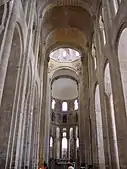
The arches of the main aisle are simple rounded arches. These arches are echoed in the arches of the gallery which are half of the main arches' height with central supporting piers. Narrower versions of these arches are also found in the apse. The aisle around the apse is separated from the sanctuary by pillars and by the chapels which open up off of the transept.[5] There are three radiating chapels off of the apse[7] and two chapels off of the transept.[8] The side aisles are roofed with a barrel vault that was originally covered with stucco.[5] The nave at Conques is roofed with a continuous barrel vault which is 60 cm thick. The nave is divided into bays by piers which rise through the gallery and over the barrel vault. The piers of the naves are huge stone blocks laid horizontally and covered with either four half-columns or four pilasters. The interior of the church is 20.70 meters tall with the sense of verticality being intensified by the repeating pattern of half-columns and pilasters approaching the high altar. The barrel vault's outward thrust is met by the half barrels of the galleries which run the length of the nave and transept.[6]
The crossing dome is a delicate octagon set in square. Ribs radiate out from the center. Figures in the squinches are angels with realistic expressions and animated eyes.[5]
There are 212 columns in Conques with decorated capitals. The capitals are decorated with a variety of motifs including palm leaves, symbols, biblical monsters and scenes from the life of Sainte-Foy.[2] On the fifth capital of the north side of the nave are two intricate and expressive birds. On the corresponding capital on the south side of the nave are flat and lifeless human figures. The figures appear to have a slight hunch, as if they are reacting to the weight of the arches above them.[5] The capitals functioned as didactic picture books for both monks and pilgrims.[4] Traces of color are still visible on a number of the columns.[6]
Light filters into Conques through the large windows under the groin vaults of the aisle and through the low windows under the half barrels of the galleries. The windows in the clerestory and the light from the ambulatory and radiating chapels focus directly onto the high altar. The nave receives direct light from the crossing tower.[6]
The original windows have long since vanished and after WWII the spaces were filled with colourful figurative glass designs. Over time these came to been seen to be at odds with the original spirit of the architecture. In 1986, the artist Pierre Soulages accepted an invitation by the Culture Ministry and the Arts Delegation and Heritage Direction for St.-Foy Abbey-church to design and create 104 windows (95 full windows and 9 oculi) for the building. Soulages designed abstract, rows of gently bending lines that shift in direction from panel to panel. He created the windows from reconstituted crushed white glass in order to keep the purity and the power of the bay architecture. Pierre Soulages' stained-glass windows are nowadays an integral element of Conques architecture, history and its collective memory "in accordance with the function of this architecture and the emotion felt in this space, agreeing with its purpose of contemplation, meditation and prayer"[9]
The ambulatory allowed pilgrims to glimpse into the sanctuary space through a metal grill.[10] The metal grill was created out of donated shackles from former prisoners who attributed their freedom to Sainte-Foy.[2] The chains also have a number of symbolic meanings including reminding pilgrims of the ability of Sainte-Foy to free prisoners and the ability of monks to free the penitent from the chains of sin. The stories associated with the ability of Sainte-Foy to free the faithful follows a specific pattern. Often a faithful pilgrim is captured and chained about the neck, they pray to Sainte-Foy and are miraculously freed. The captor is sometimes tortured and then dismissed. The liberated pilgrims would then immediately travel to Conques and dedicate their former chains to Sainte-Foy relaying their tale to all who would listen. As stories spread pilgrimage traffic increased.[1]
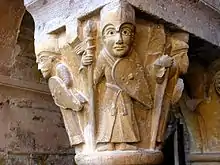
There is little exterior ornamentation on Conques except necessary buttresses and cornices. The exception to this is the Last Judgment tympanum located above the western entrance. As pilgrimages became safer and more popular the focus on penance began to wane. Images of doom were used to remind pilgrims of the purpose of their pilgrimage.[11] The tympanum appears to be later than the artwork in the nave. This is to be expected as construction on churches was usually begun in the east and completed in the west.[5] The tympanum depicts Christ in Majesty presiding over the judgment of the souls of the deceased. The cross behind Christ indicates he is both Judge and Savior. Archangel Michael and a demon weigh the souls of the deceased on a scale. The righteous go to Christ's right while the dammed go to Christ's left where they are eaten by a Leviathan and excreted into Hell. The tortures of Hell are vividly depicted including poachers being roasted by the very rabbit they poached from the monastery.[2] The tympanum also provides an example of cloister wit. A bishop who governed the area of Conques but was not well liked by the monks of Conques is depicted as being caught in one of the nets of Hell.[11] The virtuous are depicted less colorfully.[2] The Virgin Mary, St. Peter and the pilgrim St. James stand on Christ's left. Above their heads are scrolls depicting the names of the Virtues. Two gable shaped lintels act as the entrance into Heaven. In Heaven Abraham is shown holding close the souls of the righteous.[7] A pudgy abbot leads a king, possibly Charlemagne, into heaven. Sainte-Foy is shown on the lower left kneeling in prayer and being touched by the outstretched hand of God. Particularly interesting are carvings of the "curieux" (the curious ones), forerunners of the World War II-era cartoon image known as Kilroy, who peek over the edges of the tympanum. The tympanum was inspired by illuminated manuscripts and would have been fully colored, small traces of the color survive today.[7]
Treasury
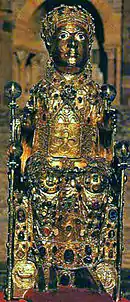
Conques is the home of many spectacular treasures. One of which is the famous 'A' of Charlemagne. The legend is that Charlemagne had twenty-four golden letters created to give to the monasteries in his kingdom. Conques received his 'A' indicating that it was his favorite.[2] This is only legend; while the "A" exists it dates to c. 1100 and no other pieces of Charlemagne's alphabet have ever been found.[12] Conques is also home to an arm of St. George the Dragon Slayer. It is claimed that the arm at Conques is the arm with which he actually slew the dragon.
The golden statue reliquary of Sainte-Foy dominated the treasury of Conques. Catching a glimpse of the reliquary was the main goal of the pilgrims who came to Conques. The head of the reliquary contains a piece of skull which has been authenticated.[2] The reliquary is a fifth-century Roman head, possibly the head of an emperor, mounted on a wooden core covered with gold plating. Made in the latter half of the ninth-century, the reliquary was 2 feet 9 inches tall. As miracles reportedly increased, the gold crown, earrings, gold throne, filigree work and cameos and jewels, mostly donations from pilgrims, were added. In the fourteenth-century a pair of crystal balls and their mounts were added to the throne. Silver arms and hands were added in the sixteenth century. In the eighteenth-century bronze shoes and bronze plates on the knees were added.[6] There is no one distinct, credited artist for this reliquary because it is a dynamic work of art that changed with the incoming donations to the church over time.[13] The relics themselves were stolen from the nearby town of Agen by the monks of Conques in what was commonly called a furtum sacrum, or holy robbery.[14]
In the aftermath of the French Revolution, the relics and treasures were removed by local residents and hidden nearby, while the sanctuary was converted to a "Temple of Reason." Upon visiting Conques in 1833, the author and antiquary Prosper Mérimée, then France's Inspector of Historical Monuments found the abbey beyond repair, but inspired thorough restorations of the church. In 1873, Norbertine order (Premonstratensians) were assigned as the Catholic caretakers of the church.[15]
The Sainte-Foy abbey church was added to the UNESCO World Heritage Sites in 1998, as part of the World Heritage Sites of the Routes of Santiago de Compostela in France. Its Romanesque architecture, albeit somewhat updated in places, is displayed in periodic self-guided tour opportunities, especially of the upper level, some of which occur at night with live music and appropriately-adjusted light levels.
Gallery

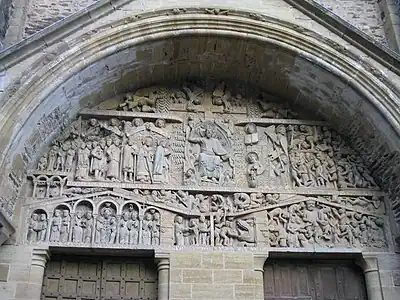 Abbey-church doorway carving
Abbey-church doorway carving Abbey-church doorway carving detail
Abbey-church doorway carving detail Abbey-church doorway carving detail
Abbey-church doorway carving detail Abbey-church doorway carving detail
Abbey-church doorway carving detail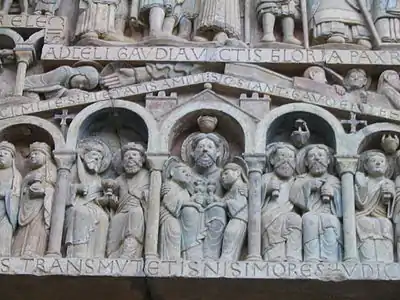 Abbey-church doorway carving detail
Abbey-church doorway carving detail Abbey-church doorway carving detail
Abbey-church doorway carving detail Abbey-church doorway carving detail
Abbey-church doorway carving detail The Majesté de Sainte Foy with roses, on Saint-Foy day (October 2010).
The Majesté de Sainte Foy with roses, on Saint-Foy day (October 2010). Procession on Saint-Foy day in Conques on October 6, 2013
Procession on Saint-Foy day in Conques on October 6, 2013.jpg.webp) Golden statue reliquary of Sainte-Foy (October 6, 2013)
Golden statue reliquary of Sainte-Foy (October 6, 2013)
References
- 1 2 Sinram, Marianne (1993). "Representations of the Feminine in the Middle Ages". In Baker, Derek (ed.). Faith and Bondage: The Spiritual and Political Meaning of Chains at the Church of Ste-Foy de Conques. Academia Press. pp. 227–90.
- 1 2 3 4 5 6 7 8 9 Brockman, Norbert C. (13 September 2011). Encyclopedia of sacred places (2nd ed.). Santa Barbara, Calif.: ABC-CLIO. pp. 109–11. ISBN 978-1-59884-654-6.
- ↑ Base Mérimée: Ancienne abbaye Sainte-Foy, Ministère français de la Culture. (in French)
- 1 2 3 Stoddard, Whitney S. (1966). Art and Architecture in Medieval France. Boulder, Co.: Westview Press. p. 35.
- 1 2 3 4 5 6 7 Vernon, Eleanor (1963). "Romanesque Churches of the Pilgrimage Road". Gesta (Pre-Serial Issue): 12–15. doi:10.2307/766600. JSTOR 766600. S2CID 192619929.
- 1 2 3 4 5 Stoddard, Whitney S. (1966). Art and Architecture in Medieval France. Boulder, Co.: Westview Press. pp. 31–33.
- 1 2 3 Evans, Joan (1969). Art in Medieval France. Oxford: Oxford University Press. pp. 23, 38.
- ↑ Stoddard, Whitney S. (1966). Monastery and Cathedral in France. Middletown, Connecticut: Wesleyan University Press. p. 58.
- ↑ PAGE, HOME. "contemporary art glass windows by Pierre Soulages - HOME PAGE". www.tourisme-conques.fr. Retrieved 26 March 2023.
- ↑ Lyman, Thomas W. (1988). "The Politics of Selective Eclecticism: Monastic Architecture, Pilgrimage Churches and Resistance to Cluny". Gesta. 27 (1/2): 83–92. doi:10.2307/766996. JSTOR 766996. S2CID 156581597.
- 1 2 Spivey, Nigel J. (2001). Enduring Creation: Art, Pain and Fortitude. Berkeley, CA: University of California Press. p. 84.
- ↑ Cynthia Hahn (2010). "Relics and Reliquaries: The Construction of Imperial Memory and Meaning, with Particular Attention to Treasuries at Conques, Aachen and Quedlinburg". In Robert A. Maxwell (ed.). Representing history, 900–1300: art, music, history. University Park, Pennsylvania: Pennsylvania State University Press. p. 134. ISBN 978-0-271-03636-6.
- ↑ Diebold, William. Word and Image: An Introduction to Early Medieval Art. Routledge, 2001. p. 140
- ↑ Diebold, William. Word and Image: An Introduction to Early Medieval Art. Routledge, 2001. p. 139
- ↑ Gneuhs, Geoffrey (25 November 2001). "Medieval Magnificence in the Midi Pyrenees". National Catholic Register. Retrieved 8 January 2020.
The wars of religion were fierce in this part of the Massif Central of southern France. The Calvinists attacked and burned the church and the abbey. Then, in 1789, the French Revolution, heralding the Enlightenment, suppressed all the religious orders, including the canons, and turned the church of St. Foy into a "Temple of Reason." The villagers outwitted the pillagers, however, by taking the relics and treasures and hiding them in their homes and in the chestnut trees in the forests....on a visit in 1833, Prosper Mirimee, the great French writer who was also inspector-general for historical remains in France, was horrified to see the decrepit condition of St. Foy, which he considered one of the finest examples of Romanesque architecture in France. Finding the abbey beyond repair, he set about supervising the restoration of the church.
